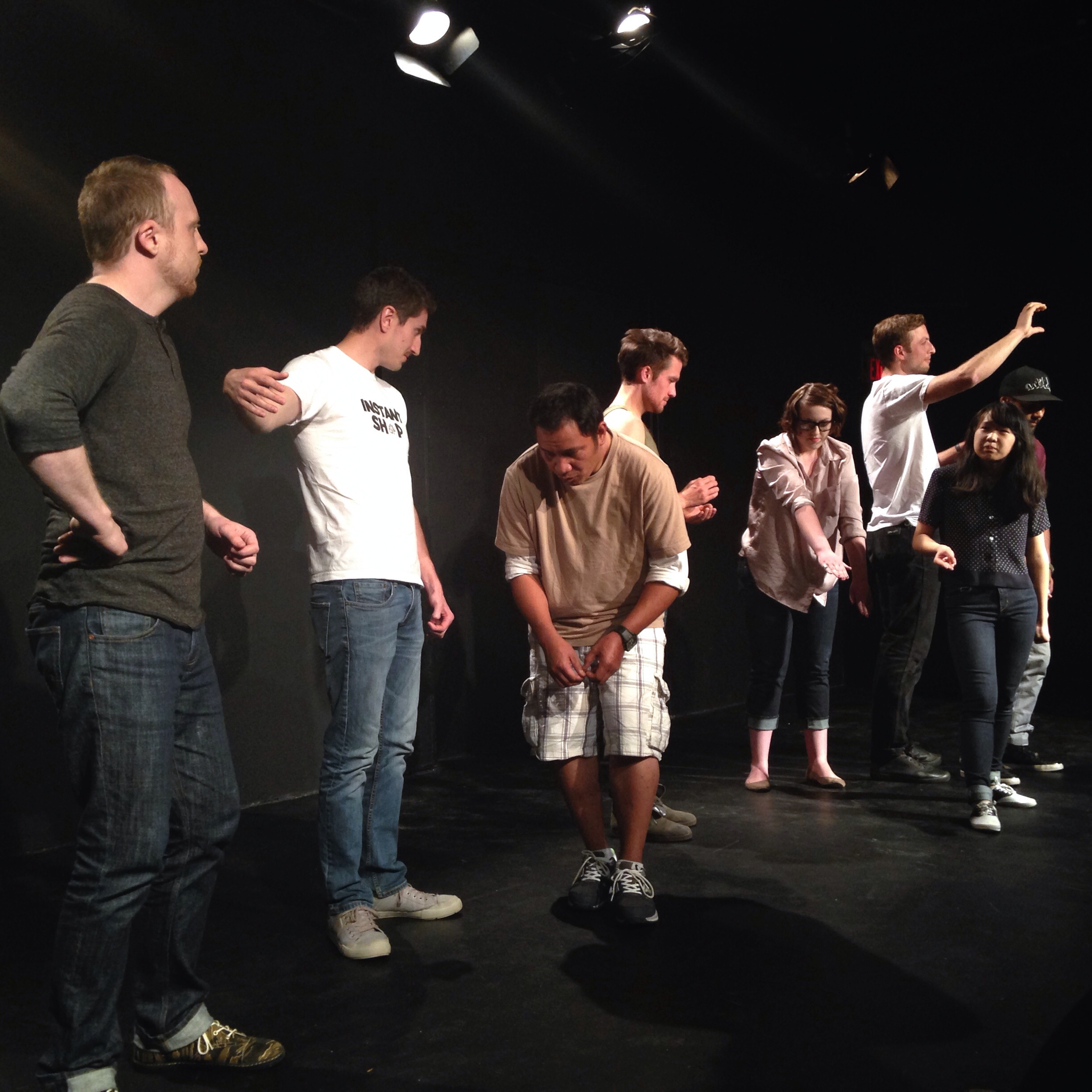Improv Games

“Yes, and” are the two most-important words in improvisation. They also sum up the nonbinary nature of play and winning in improv games.
Image by: Faruk Ates (CC)
In Games for Actors and Non-Actors, Brazilian play-write, actor and activist Augusto Boal said “[In] its most archaic sense, theatre is the capacity possessed by human beings – and not by animals – to observe themselves in action. Humans are capable of seeing themselves in the act of seeing, of thinking their emotions, of being moved by their thoughts. They can see themselves here and imagine themselves there; they can see themselves today and imagine themselves tomorrow. This is why humans are able to identify (themselves and others) and not merely to recognise.”
My experience with improv came about rather unusually.
I was working as an ESL (English as a Second Language) teacher in the Czech Republic, and one of my co-workers came to me with an interesting proposal. He had trained as an improv actor at Second City in Chicago, and though he was currently a teacher like me, he still wanted to keep acting. He was trying to start an improv troupe in Prague where he could teach a few of the games and, after we got the hang of it, even perform at some live venues.
I can’t begin to claim I am anything close to an accomplished improv actor.. What I can say, however, is how my time in Prague’s first ESL improv troupe helped shape my understanding of games, be they theatrical, analogue, or digital. Specifically, that we are far too quick to define players or winning as binary concepts within games.
Games have been a part of theatre at as long as either theatre or games have been part of human culture.
While competitive theatre games exist, most theatre and improv games have more cooperative goals in mind. The challenge may be to learn about how you move, process stimuli or convey ideas through your body. It may be to examine how you interact with others. It may be to create something, a narrative or feeling, by working with others within a specific set of constraining rules. The rules of these games define the space on the stage and how you may participate within it. The space on the stage is little different from the space on the board, the cards, or the screen.
Improv is a game of creation, where you push yourself to create new identities and stories from whatever you are given. It is also a game of empathy and understanding, where you push yourself to connect to others on a level of trust and belief strong enough to create something shared together. The closest “non-theatrical” medium would be a collaborative story-telling game such as a tabletop RPG. The performers challenge each other to build on their ideas and are challenged to incorporate whatever they are given in a logical (or at least hilarious) manner. Improv simply doesn’t work when defined by “winners” and “losers”.
To me, improv is defined by that moment where you are able to fully let go of yourself into a scene.
The moment when you trust your fellow players enough to build on whatever you put forward, and at the same time you’re in tune with them enough to build on whatever they present to you in return. The single most important lesson drilled into the head of anyone starting out in improv is “Yes, and.” The idea is that no matter what you are given by another actor, you “yes, and” it. You acknowledge what they have presented and build on it.
It doesn’t take long to learn just how vital this principle is, and how necessary trust between the actors is for it to work. Nothing halts a scene faster than an actor negating what another actor gives them. “Here we are at the beach!” “No we’re not.” Not only does this make the first actor feel rejected (and probably rightfully pissed), but it also means the scene has nowhere to go. Nothing is built upon, and the audience is immediately taken out of the scene. Instead of being about something, the scene is now just the conflict between the actors outside of the scene.
This isn’t to say that you can’t ever say “no” in a scene. Far from it. A “no, but” can build on another actor’s contribution just as much as a “yes, and”. “Hey let’s go to the beach!” “I can’t, I have severe sun allergies!” The characters are not going to the beach, but the scene still moves forward because the second actor has built on what the first actor suggested. Of course, “yes and”-ing with a “no” requires the actors to understand each other well to work. I found that when I was performing with an actor I trusted, I could embrace the scene knowing that we could both play a character and whatever happened build on each other naturally. If I didn’t trust whoever I was performing with, I spent more time focusing on the act of improv itself, constantly on guard to save myself and salvage something in the scene no matter what they negated or ignored, rather than focusing on what we could do together.
Some improv games have very specific rules and are more obviously “game-like”. These are the improv games most people are familiar with from shows like Whose Line Is It Anyways? Even within these explicit rules, the role of the performers as teammates or competitors is shifting. Who “wins” the challenge is generally the least-important concern, and the creation of characters, wordplay, scenes and ideas is much more important. Within longer scenes with less specific rules the same ideas apply. The space is defined by the rules and logic created by the players, blurring the line between traditional players and traditional “game masters.”
Any player has the freedom to put forth ideas, and every player is expected to react to whatever new rules or challenges are introduced.
What makes live improv so much fun is that the audience becomes a player in this game. Improv audiences who get into it will try to trip you up with their suggestions, be it an audience who tries to suggest the strangest things possible or lobs the filthiest suggestions possible in hopes of taking the scene down a perverted path. But no matter what they try to challenge you with, all audiences are delighted if the performers are able to incorporate the what they are given into the scene, no matter how wild or seemingly incompatible. There are improv games where this line between player, audience and game master is even more blurred; where audience members come directly on stage and exert control over the actors and scene. While the audience is challenging the performers, they only “win” the game if they get a performance they enjoy. It is still a collaborative process.
This is the moment where games and theatre blend together, where the barriers we put up between fields and mediums break down. Games and theatre are both tools through which humans directly act within a new space and recognize new ways of thinking and new ways of being within ourselves. When we look at art as a series of locked and gated communities, we see improv as being on the border between the two. But through acting in improv, we see that it is not merely the intersection of two mediums, but an example of how these mediums have always shared space together. A shared space where we are all potential actors and players creating new worlds together.

1 Comment
Fine work, Mike.
Improvisational theatre and video games have so much to teach each other, and the “Yes, and…” philosophy is invaluable in game design. Too often I’ve worked on allegedly collaborative projects where no one trusts one another and every idea is quickly rejected by someone who is married to their own inflexible vision. (Not to denigrate a creator’s stubborn, singular vision; it should, however, be kept out of collaborative workplaces.) The wildest, most inventive concepts come from accepting boundaries and finding some way to enthusiastically pile incongruous-sounding additions on top.
On the other side, players should feel welcomed into games, with the same gracious attitude one would welcome an audience or even a fellow performer. In an improv game, everyone always wants to push the rules as far as they’ll go. Video games are no different. Even in the most linear games, player actions should be “Yes, and…”ed. I think this is why Nintendo games (specifically those with a heavy Miyamoto influence) are so successful. You push a button, you get an instant reaction. You jump out of the top of the level, you’re rewarded with a hidden Warp Zone. Trap a Koopa shell on the stairs and collect infinte 1UPs. There’s an appropriate animation and sound effect for everything, letting you know that the game is right there with you. To my earlier point, think about the blocks that give multiple coins – a bug turned to a series staple – and it’s easy to see the benefit of accepting what is rather than what should be in game design. Or any interactive or entertaining work, really. Teachers with improv experience rule.